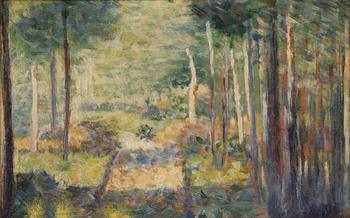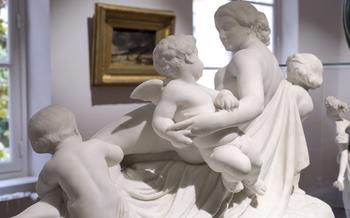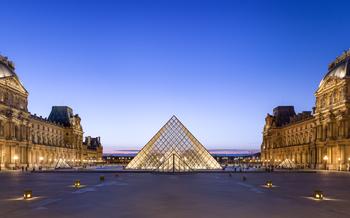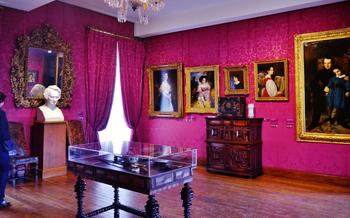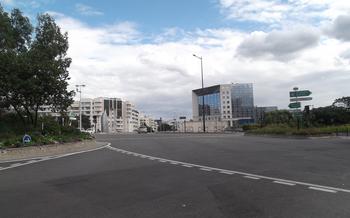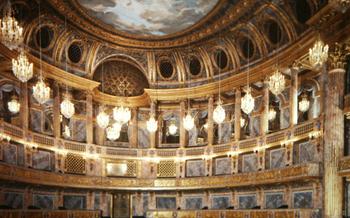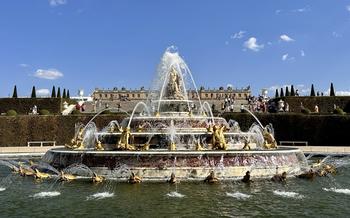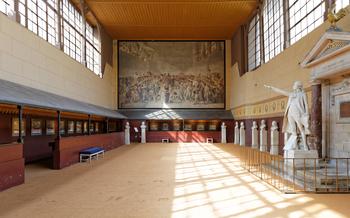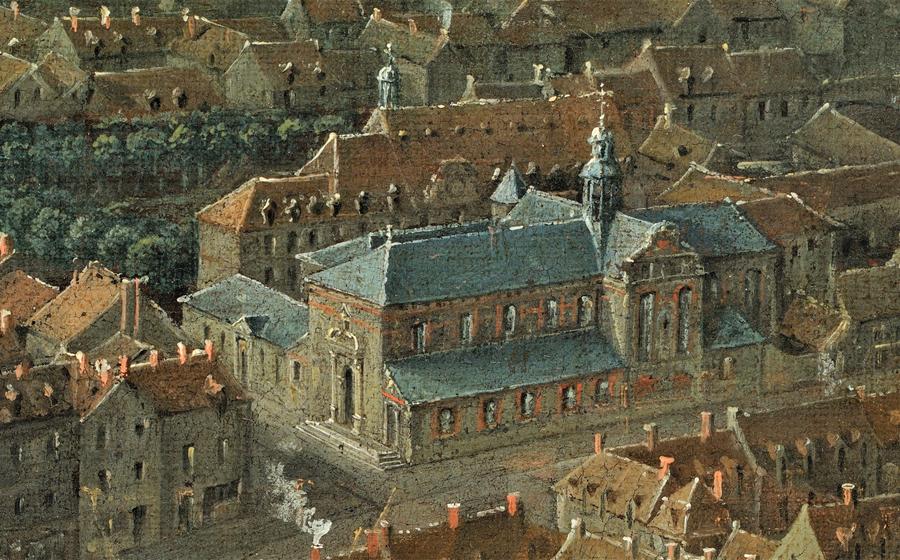
Chateau de Fontainebleau
- History and Significance
- Exploring the Chateau Interiors
- The Chateau Museum
- Special Events and Exhibitions
- Planning Your Visit
- Admission Fees and Hours
- Guided Tours
- Audio Guides
- Dining and Refreshments
- Shopping and Souvenirs
- Accessibility and Facilities
- Nearby Attractions
- Photography and Videography
- Insider Tip: The Secret Garden
History and Significance
The Château de Fontainebleau, a majestic symbol of French history and architectural splendor, stands as a testament to the grandeur of the French monarchy. Built in the 12th century as a hunting lodge for King Louis VII, the chateau underwent numerous transformations and expansions over the centuries, reflecting the changing tastes and ambitions of its royal residents. It was during the reign of King François I in the 16th century that the chateau truly blossomed, as he commissioned extensive renovations and embellishments that transformed it into a Renaissance masterpiece. Over the years, the chateau served as a favored residence for French monarchs, including Henri IV, Louis XIII, and Louis XIV, who each left their own unique mark on its design and décor. In the 19th century, Napoleon Bonaparte made the chateau his imperial palace, adding his own touches of grandeur and using it as a stage for lavish ceremonies and celebrations.
Exploring the Chateau Interiors
Venturing into the opulent interiors of the Chateau de Fontainebleau is like stepping into a bygone era of grandeur and royalty. Every corner whispers tales of the lavish lifestyles of the French monarchs who once called this magnificent palace home.
Marvel at the majestic Galerie François Ier, adorned with intricate Renaissance frescoes that depict mythological scenes and historical events. Its vaulted ceiling, a masterpiece of artistry, seems to transport visitors back in time to the court of King François I, where lavish banquets and royal ceremonies unfolded.
Stroll through the opulent chambers, each boasting unique tapestries, furnishings, and artwork that reflect the tastes and personalities of their former occupants. The Grand Salon, with its shimmering chandeliers and polished parquet floors, evokes images of lavish balls and elegant receptions hosted by the French court.
Discover the private apartments of Napoleon Bonaparte, where the emperor himself once resided. Admire his personal belongings, including his iconic hat and sword, and immerse yourself in the stories of his triumphs and tribulations.
Take advantage of the guided tours offered at the chateau to delve deeper into its rich history and anecdotes. Knowledgeable guides will regale you with tales of the monarchs, artists, and statesmen who graced these halls, bringing the chateau's past vividly to life.
Whether you choose to explore independently or with a guide, the Chateau de Fontainebleau's interiors offer a captivating journey through centuries of French history and royal splendor.
The Chateau Museum
A visit to Château de Fontainebleau is incomplete without exploring its fascinating museum, which houses a treasure trove of artifacts and artworks that narrate the rich history of the chateau and its royal inhabitants. Immerse yourself in the captivating stories of the past as you wander through the museum's thoughtfully curated exhibits.
Among the highlights of the collection are exquisite pieces of furniture that once graced the chateau's opulent chambers, each intricately carved and adorned with intricate details. Marvel at the grandeur of the royal beds, adorned with lavish fabrics and intricate canopies, and imagine the monarchs who once rested within them.
The museum's collection also boasts an impressive array of paintings, capturing the essence of court life and the changing artistic styles that adorned the chateau's walls over the centuries. Gaze upon the regal portraits of kings and queens, each brushstroke revealing their power and majesty.
For those captivated by the artistry of sculpture, the museum offers a showcase of exquisite works that depict mythological figures, historical events, and the people who shaped the chateau's legacy. These sculptures bring to life the stories of the past, allowing visitors to connect with the human drama that unfolded within these walls.
Plan ample time to explore the chateau's museum, as its collection is vast and each exhibit offers a glimpse into the lives of the French monarchy and the grandeur of their former residence.
Special Events and Exhibitions
Throughout the year, the Chateau de Fontainebleau hosts a variety of special events and exhibitions that bring its history and grandeur to life. These events offer unique opportunities to experience the chateau in different ways and learn more about its significance.
Past events have included concerts of classical music and jazz, art exhibitions showcasing the works of renowned artists, and historical reenactments that transport visitors back in time. These events are often themed around specific periods or events in the chateau's history, providing a deeper insight into the lives of the royals who resided here.
To make the most of your visit, check the chateau's website or social media pages for upcoming events and exhibitions. Advance booking is recommended for popular events, and some may require a separate admission fee. Dress codes may also apply, so be sure to dress appropriately for the occasion.
Whether you're interested in history, art, or simply experiencing the grandeur of the Chateau de Fontainebleau in a new way, these special events and exhibitions offer something for everyone.
Planning Your Visit
A visit to Château de Fontainebleau can be a rewarding experience, but careful planning can make it even better. The best time to visit is during the shoulder seasons (April-May and September-October) when the weather is pleasant, and the crowds are smaller. During the summer months, the chateau is busiest, especially on weekends and holidays. It's advisable to book your tickets online in advance to avoid long queues, particularly during peak season.
Getting to the chateau is relatively easy. If you're coming from Paris, you can take the RER D train from Gare de Lyon station to Fontainebleau-Avon station. From there, it's a short walk or bus ride to the chateau. Alternatively, you can drive, and there is ample parking available on-site.
Once you're at the chateau, you'll find several amenities to make your visit more enjoyable. There are restaurants and cafés where you can grab a bite to eat, as well as gift shops where you can purchase souvenirs. The chateau is also wheelchair accessible, and there are ramps and elevators to help visitors with accessibility needs.
Admission Fees and Hours
The Chateau de Fontainebleau offers a variety of admission options to suit different budgets and interests. Visitors can choose to purchase a ticket for the chateau only, the gardens only, or a combined ticket that includes both. Admission fees vary depending on the time of year and the type of ticket purchased.
During the high season (April to October), a full-price ticket for the chateau and gardens costs 21 euros. A reduced-price ticket is available for students, seniors, and families. Children under 18 are admitted free of charge.
During the low season (November to March), admission fees are slightly reduced. A full-price ticket for the chateau and gardens costs 17 euros. Reduced-price tickets are available for students, seniors, and families. Children under 18 are still admitted free of charge.
The chateau is open to the public every day of the week, except for Tuesdays. Hours of operation vary depending on the time of year. During the high season, the chateau is open from 9:30 am to 6:30 pm. During the low season, the chateau is open from 9:30 am to 5:30 pm.
To avoid crowds, it is best to visit the chateau during the low season or on a weekday. Guided tours are available in English and French. Reservations are recommended, especially during the high season.
Guided Tours
Enhance your visit to the Chateau de Fontainebleau by embarking on a guided tour, an exceptional opportunity to delve into the rich history and captivating stories that lie within its walls. Led by knowledgeable and passionate guides, these tours offer an immersive experience, bringing the chateau's past to life.
Available in various languages, the guided tours provide a comprehensive overview of the chateau's architectural marvels, its opulent interiors, and the fascinating lives of the monarchs who once resided here. Expert guides will captivate you with tales of royal intrigue, artistic patronage, and historical significance, ensuring that every corner of the chateau unveils its secrets.
To make the most of your guided tour, advance reservations are highly recommended, especially during peak tourist seasons. Meeting points are conveniently located within the chateau grounds, and tours typically range from one to two hours in duration, allowing ample time to explore the chateau's highlights.
Audio Guides
The Chateau de Fontainebleau offers a comprehensive audio guide service to enhance your visit. These audio guides are available in multiple languages, allowing visitors from diverse backgrounds to delve into the chateau's rich history and captivating stories. The audio commentary provides insightful information about the chateau's architecture, artwork, and historical significance, bringing each room and gallery to life.
As you stroll through the grand halls and chambers, the audio guide narrates the lives of the monarchs and influential figures who once graced these spaces. It sheds light on the events that unfolded within these walls, from lavish celebrations to political intrigues. The audio guide also offers detailed descriptions of the artwork and furnishings, allowing you to appreciate their significance and craftsmanship.
To rent an audio guide, simply approach the information desk in the chateau's main entrance. A nominal fee is charged for the rental, and you will be provided with a headset and a map to guide your exploration. The audio commentary is synchronized with your progress, ensuring that you don't miss any important highlights.
Whether you prefer to explore at your own pace or delve deeper into the chateau's history, the audio guide is an invaluable tool. It's an excellent way to enrich your visit and gain a deeper understanding of this magnificent royal residence.
Dining and Refreshments
A visit to the Chateau de Fontainebleau is not complete without indulging in the culinary delights offered within its grounds. Several dining options cater to the diverse needs of visitors, ensuring a memorable gastronomic experience.
The Orangerie Restaurant is a popular choice for those seeking a refined dining experience. Nestled amidst the lush greenery of the gardens, this elegant restaurant offers a menu that showcases the finest seasonal ingredients, prepared with creativity and precision. Enjoy panoramic views of the chateau as you savor dishes that celebrate French cuisine while incorporating contemporary culinary trends.
For a more casual dining experience, the Pavillon des Platanes is an excellent option. Located near the Grand Parterre, this charming café offers a variety of light meals, snacks, and refreshments. Take a break from your exploration of the chateau and enjoy a leisurely lunch or afternoon tea in the tranquil ambiance of the gardens.
If you prefer a quick bite to eat, the Snack du Jardin is conveniently situated near the entrance to the gardens. Offering a selection of sandwiches, salads, and pastries, this snack bar is ideal for those on the go or looking for a quick and affordable meal.
No matter your preference, the Chateau de Fontainebleau offers a range of dining options that will satisfy your culinary cravings and enhance your overall experience.
Shopping and Souvenirs
At Château de Fontainebleau, visitors will find two gift shops offering a wide range of souvenirs to commemorate their visit. One shop is located near the entrance to the chateau, while the other is situated in the gardens. Both shops stock a variety of items, including books about the chateau's history and architecture, postcards featuring stunning images of the chateau and its grounds, and replicas of historical artifacts such as jewelry, weapons, and furniture.
For those looking for unique and memorable souvenirs, the gift shops offer a selection of handcrafted items made by local artisans. These include pottery, glassware, and textiles featuring designs inspired by the chateau's rich history. Visitors can also purchase gourmet food products, such as jams, honey, and chocolates, made with ingredients from the chateau's own gardens.
When shopping for souvenirs at Château de Fontainebleau, it's important to remember that the proceeds from sales directly support the preservation and restoration of the chateau and its grounds. By purchasing a souvenir, visitors can contribute to the ongoing efforts to protect this magnificent historical landmark for future generations. So whether you're looking for a small token to remember your visit or a special gift for a loved one, be sure to visit the gift shops at Château de Fontainebleau.
Accessibility and Facilities
The Chateau de Fontainebleau is committed to providing a welcoming and accessible environment for all visitors. The chateau features a number of accessibility features to ensure that everyone can enjoy their visit, including:
- Wheelchair accessibility: The chateau is wheelchair accessible, with ramps and elevators providing access to all levels of the building. Wheelchairs are also available for rent at the chateau's information desk.
- Restrooms: There are accessible restrooms located throughout the chateau.
- Baby changing facilities: Baby changing facilities are available in the chateau's restrooms.
- Other visitor amenities: The chateau also offers a variety of other visitor amenities, such as a cloakroom, a gift shop, and a café.
Visitors with disabilities or special needs are encouraged to contact the chateau in advance of their visit to inquire about any specific accommodations or assistance they may require.
Nearby Attractions
A visit to Château de Fontainebleau can be easily combined with other attractions in the surrounding area. History buffs might want to explore the nearby town of Barbizon, renowned for its association with the Barbizon School of painting. Nature enthusiasts can stroll through the vast Fontainebleau Forest, just a short drive away, or visit the Parc des Félins, a wildlife park dedicated to big cats. To delve deeper into French history, consider a trip to the Palace of Versailles, the former royal residence of the French monarchy, located about an hour's drive from Fontainebleau. For a unique experience, take a hot air balloon ride over the picturesque landscapes of the Île-de-France region, offering breathtaking views of the chateau and its surroundings.
Photography and Videography
At Château de Fontainebleau, capturing the grandeur of the palace and its surroundings through photography and videography is an enriching experience. The chateau's management recognizes the desire of visitors to document their visit and share their memories. Here are some guidelines and tips to ensure a successful photography and videography experience:
- Permitted Areas:
- Visitors are generally allowed to take photographs and videos for personal, non-commercial use in most areas of the chateau, including the exterior, the courtyards, and the gardens.
-
The interiors of the chateau, however, may have restricted photography due to conservation concerns. Please respect the signs and instructions provided in each room.
-
Tripods and Equipment:
- Tripods and other photography equipment are generally permitted in the outdoor areas of the chateau. However, their use inside the palace may be restricted to avoid obstructing other visitors or damaging the exhibits.
-
Flash photography is not allowed inside the chateau to prevent damage to the artwork and furnishings.
-
Composition and Lighting:
- The chateau's vast grounds and intricate architecture provide endless opportunities for creative photography. Take advantage of the natural light and shadows to capture the essence of the palace.
-
For interior shots, consider using a wide-angle lens to capture the grandeur of the halls and rooms.
-
Respect for Privacy:
-
Please be mindful of other visitors when taking photographs or videos. Avoid capturing people without their consent, especially in private areas or during events.
-
Sharing Your Creations:
- If you share your photos or videos online, please consider using relevant hashtags related to the chateau, such as #ChateauDeFontainebleau or #FontainebleauPalace, to connect with other enthusiasts.
Insider Tip: The Secret Garden
Beyond the manicured lawns and formal gardens of Fontainebleau lies a hidden gem: the Secret Garden. Tucked away in a secluded corner of the estate, this enchanting space is a world unto itself. Here, visitors can wander amidst towering trees, vibrant flower beds, and tranquil ponds. The air is filled with the sound of birdsong and the scent of jasmine.
The Secret Garden was created in the 18th century as a private retreat for the royal family. It was designed in the English style, with winding paths, rustic follies, and a picturesque lake. Over the years, the garden has been lovingly restored and maintained, preserving its original charm and tranquility.
To find the Secret Garden, follow the signs from the main gardens. As you enter, you will feel as if you have stepped back in time. The garden is a haven of peace and tranquility, a place to escape the hustle and bustle of the chateau and immerse yourself in the beauty of nature.
Take your time exploring the Secret Garden. Discover the hidden corners, admire the flowers, and listen to the birdsong. You may even spot a deer or a rabbit darting through the undergrowth. This is a place to relax, reflect, and connect with your inner self.
So, if you are looking for a truly unique and memorable experience at Fontainebleau, be sure to seek out the Secret Garden. It is a hidden gem that is sure to delight and inspire you.
